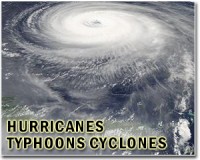| . |  |
. |
Sydney (AFP) Feb 17, 2011 A tropical cyclone lashing northern Australia weakened to a low pressure system after crossing land near Darwin on Thursday, bringing wild winds and torrential rains. Carlos, a category one of five storm, was downgraded after making landfall overnight, toppling trees and power lines over roads and homes, and sparking flash flooding across the remote northern city. "The cyclone has weakened into a tropical low and winds near the centre have moderated below gale force," the weather bureau said. Almost 770 millimetres (30 inches) of rain lashed Darwin in the past week -- more than double the monthly average -- causing the city's dam to overflow and flooding at least 30 homes. "Looks like our fridge is about to float away downstairs," Bees Creek resident Dale told ABC Radio. "I don't want to let anyone downstairs before all the water's gone and I've had a look around for snakes and crocodiles," he added. Darwin's airport, closed because of the cyclone, was due to reopen Thursday but schools and other services remained shut, city officials said. Carlos could re-intensify to cyclone strength as it approached the border of resources-rich Western Australia state on Saturday, the weather bureau added. A second cyclone, Dianne, had formed off the state's Pilbara iron ore region and was gathering force as it drifted south. It was expected to reach category three by Saturday but was almost 400 kilometres (250 miles) offshore and unlikely to hit Australia, the weather bureau said. The storms come just two weeks after top-strength cyclone Yasi ploughed into northeastern Australia's Great Barrier Reef coast, destroying small towns and wreaking Aus$1 billion (US$1 billion) in damage, but not causing any deaths. Australia has been hit by five tropical cyclones this year and suffered weeks of devastating flooding that killed 35 people, swamped tens of thousands of homes and brought Brisbane, its third-largest city, to a halt. The wild weather has been linked to an especially strong La Nina weather pattern in the Pacific, which traditionally brings cyclones and floods to the vast country.
earlier related report The Reserve Bank of Australia said last month's inundation of a huge area of mining, farming and tourism state Queensland would have "significant short-term effects on output and prices". "The biggest effect on GDP was likely to arise from swings in coal production, with many Queensland mines severely affected by wet weather since December," the bank said in the minutes to its latest interest rate meeting, published Tuesday. "Preliminary estimates suggested that national coal production would be around 15 percent lower over the December and March quarters than would otherwise have been the case." The bank, which held interest rates steady at 4.75 percent this month, said the "cumulative effect of lost production... from the floods would result in the level of GDP being around one percentage point lower in the March quarter". It would bounce back strongly as the recovery ramped up to slightly above pre-flood forecasts by the June quarter, the RBA said, with medium-term prospects "largely the same as they had been prior to the floods". Treasurer Wayne Swan has flagged a 0.5 percentage point drop in growth for the current fiscal year due to the floods, which killed 35 people and brought the nation's third-largest city, Brisbane, to a standstill. Swan warned he "couldn't rule out" negative growth for the March quarter, which would be the first contraction for Australia's mining-powered economy since the global financial crisis. The coal industry, which flooding virtually shut down in Queensland last month, stood to lose about Aus$5 billion (US$5.02 billion) in exports from the crisis, while agriculture could take a Aus$2 billion hit, Swan said. The floods were followed by a top-level cyclone which Treasury estimates wiped out Aus$700 million in rural production, Aus$200 million in coal exports and Aus$100 million in tourism activity. Australia's economy grew a worse-than-expected 0.2 percent quarter on quarter in the three months to the end of September, the most recent available figure, which was the slowest since the depths of the financial crisis.
Share This Article With Planet Earth
Related Links Bringing Order To A World Of Disasters When the Earth Quakes A world of storm and tempest
 Devastation at epicentre of Australian mega-cyclone
Devastation at epicentre of Australian mega-cycloneCardwell, Australia (AFP) Feb 4, 2011 Smashed yachts lay stacked like matchwood near a marina, while the ruined husk of a church, its walls sheered off as if from tank fire, stood vigil amidst the ruins of Cyclone Yasi. As rescuers struggled Friday to get to areas worst hit by Severe Tropical Cyclone Yasi's 290-kilometre (180-mile) per hour winds, they witnessed scenes of destruction that rival a war zone. Although rescuers ... read more |
|
| The content herein, unless otherwise known to be public domain, are Copyright 1995-2010 - SpaceDaily. AFP and UPI Wire Stories are copyright Agence France-Presse and United Press International. ESA Portal Reports are copyright European Space Agency. All NASA sourced material is public domain. Additional copyrights may apply in whole or part to other bona fide parties. Advertising does not imply endorsement,agreement or approval of any opinions, statements or information provided by SpaceDaily on any Web page published or hosted by SpaceDaily. Privacy Statement |